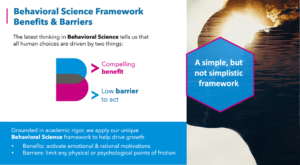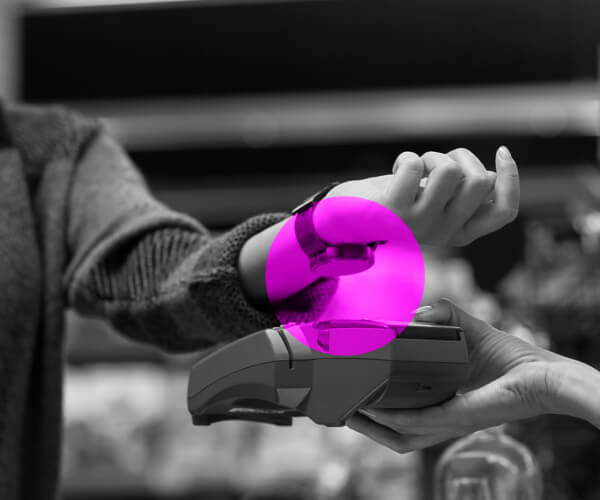A Case for Simple, Actionable Behavioral Research – Post 1
When we rebranded as Behaviorally in early 2021, it was with deep acknowledgement of behavioral science as the foundation of all our work. It is the basis on which we leveraged decades of category expertise and cutting-edge digital technology to help clients reach their growth objectives by understanding how consumers react to their shopper marketing.
For those who may be new to the Behaviorally brand promise, we thought it might be worth revisiting our behavioral framework, explaining how it is unique and showcasing how it works practically in our consultancy with clients who are seeking solutions to create value in their marketing.
In this series, we will address the reasons for behavioral science as the foundation for defining and diagnosing the influences that drive consumer choice in retail. We will also review how our unique behavioral framework is the most effective way to achieve this and drive value in marketing. We will also explore the academic rigor behind how our model works and provide examples of how we have applied it to actual brand challenges to drive better outcomes.
Why Behavioral Science?
Whether you trace its origins to Daniel Kahneman or Dan Ariely, behavioral science is decades old, and well accepted as the gold standard for understanding the way the human brain works to drive most decisions. In fact, in a time of tremendous unpredictability, especially for brands trying to win in retail, we believe it is the one constant to understand how consumers make choices and shop the way they do. Applying behavioral metrics effectively reveals those factors that influence shoppers to make the choices that can make or break your brand.
Many market research agencies over the last decade have jumped on the “BeSci” bandwagon, quoting increasingly popular behavioral memes, and trying to tie themselves to the slogans that have stood for proxies to the science. Ironically, this is often just talk and many agencies have continued to do the same kind of research they have always done, just with a “behavioral” label.
And some agencies, attempting to appear serious, have overcomplicated the basic truths about behavioral science with highly complex “influencers” of behavior, while at the same time failing to tie their behavioral research to actionable results.
Other agencies may have a framework. They may talk about “heuristics”. They may have lots of book lists and articles with interesting findings, most often focused on social experiments like smoking cessation and increasing recycling compliance.
But when a consumer goods client has a marketing or retail channel challenge, these agencies are often hard pressed to tie all their “theoretical advice” to practical recommendations that brands can actually use to create value through their marketing.
What we hear most frequently from clients is an urgent desire to harness behavioral science to define clear, pragmatic, and direct paths to driving growth in retail.
The anchor principles behind our research methodologies have been behavioral for decades, even before the term became ubiquitous. So, when we respond to such client objectives, we can genuinely claim behavioral science and category expertise as part of our DNA. The proof is in how we have made the principles uniquely our own, and how we can show the impact they have had on our own clients’ marketing decisions.
How our Behavioral Framework is Unique
In order to practically apply the theories of behavioral science as the foundations for operational decision-making in marketing, you must start with a validated and effective framework. Our approach in refining our framework has been to leverage our decades of shopper marketing expertise and position behavioral science as the one constant in a time of volatility and uncertainty for brands AND consumers.
We start from the conviction that human choices (none more so than in shopper) are driven predominantly by two things:
- A compelling benefit (e.g., motivation)
- A low barrier to act (the absence of friction)
Following this conviction, we developed our behavioral framework based on three very important components. It is:
- Simple but not simplistic
- Grounded in academic rigor
- Capable of delivering actionable recommendations that support the most important moment in marketing: when a consumer makes a purchase
 Simply put, when we explore a client’s marketing challenge, we apply a behavioral lens that identifies the Benefits and Barriers to a consumer take an action at the digital or physical shelf.
Simply put, when we explore a client’s marketing challenge, we apply a behavioral lens that identifies the Benefits and Barriers to a consumer take an action at the digital or physical shelf.
In order to be Selected and placed in the virtual or physical cart and purchased, products must:
- Convery a compelling Benefit and motivate a selection.
- Eliminate any friction that creates a Barrier to the transaction.
In our next posts in this series, we will expand on these points, demonstrate how the framework is simple but effective, backed by rigorous academic exploration, and validated by examples of how we have applied it in real client cases.
In the meantime, if you want to know more about applying this framework to your own retail challenges, please contact your local Behaviorally expert.
